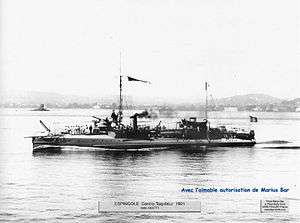French destroyer Fauconneau
Fauconneau was one of four Durandal-class destroyers built for the French Navy in the late 1890s.
 Sister ship Espingole moving at slow speed in harbor | |
| History | |
|---|---|
| Name: | Fauconneau |
| Namesake: | Falconet |
| Ordered: | 1896 |
| Builder: | Chantiers et Ateliers Augustin Normand, Le Havre |
| Launched: | 2 April 1900 |
| Stricken: | 15 January 1921 |
| Fate: | Sold for scrap, 20 April 1921 |
| General characteristics | |
| Class and type: | Durandal-class destroyer |
| Displacement: | 311 t (306 long tons) |
| Length: | 57.64 m (189 ft 1 in) |
| Beam: | 6.3 m (20 ft 8 in) |
| Draft: | 3.2 m (10 ft 6 in) |
| Depth: | 4.1 m (13 ft 5 in) |
| Installed power: |
|
| Propulsion: |
|
| Speed: | 26 knots (48 km/h; 30 mph) |
| Range: | 2,300 nmi (4,300 km; 2,600 mi) at 10 knots (19 km/h; 12 mph) |
| Complement: | 52 officers and enlisted men |
| Armament: |
|
Design and description
The Durandals had an overall length of 57.64 meters (189 ft 1 in), a beam of 6.3 meters (20 ft 8 in), and a maximum draft of 3.2 meters (10 ft 6 in).[1] They displaced 311 metric tons (306 long tons) at deep load. The two triple-expansion steam engines, each driving one propeller shaft, were designed to produce a total of 5,200 metric horsepower (3,825 kW), using steam provided by two Normand boilers.[2] The ships had a designed speed of 26 knots (48 km/h; 30 mph), but Fauconneau reached 27.14 knots (50.26 km/h; 31.23 mph) during her sea trials.[1] The ships carried enough coal to give them a range of 2,300 nautical miles (4,300 km; 2,600 mi) at 10 knots (19 km/h; 12 mph). Their original complement consisted of four officers and sixty enlisted men, but the number of enlisted men increased to 60 in 1899.[2]
The Durandal-class ships were armed with a single 65-millimeter (2.6 in) gun forward of the bridge and six 47-millimeter (1.9 in) Hotchkiss guns, three on each broadside. They were fitted with two single 381-millimeter (15 in) torpedo tubes, one between the funnels and the other on the stern. Two reload torpedoes were also carried; their air flasks, however, had to be charged before they could be used, a process that took several hours. The Modèle 1887 torpedo that they used had a warhead weight of 42 kilograms (93 lb).[2]
Construction and career
Fauconneau was ordered from Chantiers et Ateliers Augustin Normand and the ship was launched on 2 April 1900 at its shipyard in Le Havre. She began her sea trials on 5 July 1900.[1]
During World War I, Fauconneau scuttled the French destroyer Fantassin in the Ionian Sea on 5 June 1915 after Fantassin suffered serious damage in a collision with the French destroyer Mameluck.[3]
References
- Couhat, p. 82
- Caresse, p. 97
- "French Navy". Naval History. Retrieved 21 February 2013.
Bibliography
- Caresse, Philippe (2013). "The Unlucky Destroyer Espignole". In Jordan, John (ed.). Warship 2013. London: Conway. ISBN 978-1-84486-205-4.
- Chesneau, Roger & Kolesnik, Eugene M. (1979). Conway's All The World's Fighting Ships 1860–1905. London: Conway Maritime Press. ISBN 0-85177-133-5.
- Couhat, Jean Labayle (1974). French Warships of World War I. London: Ian Allan. ISBN 0-7110-0445-5.